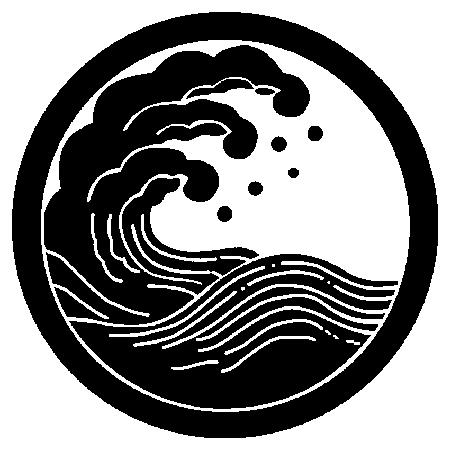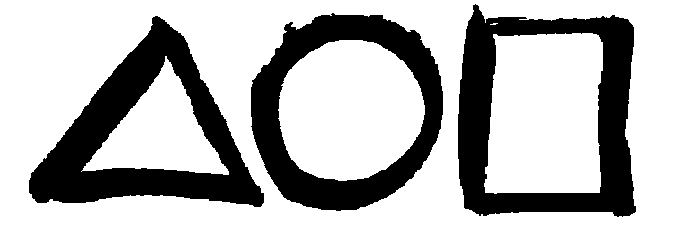 Sokaku Takeda was born into a samurai family in Aizu, present day Fukushima Prefecture, at the end of the samurai era. He had an austere and rather harsh
childhood, training in a variety of samurai arts including kenjustsu, yari, sumo, and jujutsu. As a young man he travelled extensively, training in many dojos and fighting many duels. In
1898, with the age of the samurai fading, he began concentrating on jujutsu at the urging of his teacher, Tanomo Saigo. In 1915 he accepted Morihei Ueshiba as a student in Hokkaido. After
1920, his relationship with Ueshiba became strained, but he continued to visit Ueshiba and teach his students into the thirties. He continued travelling and teaching until his death in
1943, despite a stroke in 1941.
Sokaku Takeda was born into a samurai family in Aizu, present day Fukushima Prefecture, at the end of the samurai era. He had an austere and rather harsh
childhood, training in a variety of samurai arts including kenjustsu, yari, sumo, and jujutsu. As a young man he travelled extensively, training in many dojos and fighting many duels. In
1898, with the age of the samurai fading, he began concentrating on jujutsu at the urging of his teacher, Tanomo Saigo. In 1915 he accepted Morihei Ueshiba as a student in Hokkaido. After
1920, his relationship with Ueshiba became strained, but he continued to visit Ueshiba and teach his students into the thirties. He continued travelling and teaching until his death in
1943, despite a stroke in 1941.
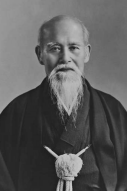 Morihei Ueshiba was born in 1883 in Tanabe, Wakayama Prefecture, to a prosperous family with interests in farming and timber. He
was a sickly child, but studied martial arts and became strong. In 1903, Ueshiba enlisted in the army and served in the Russo-Japanese war. During his time in the military he studied
Yagyu shingan ryu jujutsu. In 1912 Ueshiba migrated to the wilds of Hokkaido with a group of settlers. In 1915 he met Sotaku Takeda and began studying Daito Ryu jujutsu. Ueshiba studied
Daito Ryu intensely for several years. In 1919 Ueshiba received word that his father was dying. He wrapped up his affairs in Hokkaido, giving his house to Takeda. On the train to Tanabe
he met a follower of the Omoto religion. Ueshiba detoured to Ayabe, to ask the leader of Omoto, Onisaburo Deguchi, to pray for his father. On reaching Tanabe, Ueshiba found that his
father had passed on. He later moved his family to Ayabe, and became closely associated with Onisaburo. He began teaching his art to Omoto followers, calling it Aikibujutsu. In 1924
Onisaburo led a party to Mongolia to create a utopian nation in that region. Ueshiba accompanied the party. They had many adventures and survived harrowing experiences. After returning to
Japan, Ueshiba had a spiritial awakening and renamed his art Aiki-budo, the martial way of Aiki. Ueshiba's growing skill and notariety attracted the attention of members of the military
government. With their help he began teaching at the Japanese military schools, and moved to Tokyo in 1927. Through the thirties Ueshiba taught in Tokyo and around Japan, including at the
main Japanese military academies. At the end of the thirties, Ueshiba's students began to stop training as they enlisted or were conscripted into the military in preparation for the war.
In 1942 the war was raging and Ueshiba was in poor health. He retired to Iwama, a small farming village northeast of Tokyo where he had bought land. Ueshiba regained his health and
resumed vigorous training and intense meditation, modifying his art into its modern form and renaming it Aikido. In the early fifties Ueshiba began sending teachers to other countries,
giving Aikido to the world. In 1961, he made his only trip to the United States, teaching seminars in Hawaii. Ueshiba continued teaching and training in Iwama until his death in 1969. He
was known to his students as O-sensei, meaning great teacher.
Morihei Ueshiba was born in 1883 in Tanabe, Wakayama Prefecture, to a prosperous family with interests in farming and timber. He
was a sickly child, but studied martial arts and became strong. In 1903, Ueshiba enlisted in the army and served in the Russo-Japanese war. During his time in the military he studied
Yagyu shingan ryu jujutsu. In 1912 Ueshiba migrated to the wilds of Hokkaido with a group of settlers. In 1915 he met Sotaku Takeda and began studying Daito Ryu jujutsu. Ueshiba studied
Daito Ryu intensely for several years. In 1919 Ueshiba received word that his father was dying. He wrapped up his affairs in Hokkaido, giving his house to Takeda. On the train to Tanabe
he met a follower of the Omoto religion. Ueshiba detoured to Ayabe, to ask the leader of Omoto, Onisaburo Deguchi, to pray for his father. On reaching Tanabe, Ueshiba found that his
father had passed on. He later moved his family to Ayabe, and became closely associated with Onisaburo. He began teaching his art to Omoto followers, calling it Aikibujutsu. In 1924
Onisaburo led a party to Mongolia to create a utopian nation in that region. Ueshiba accompanied the party. They had many adventures and survived harrowing experiences. After returning to
Japan, Ueshiba had a spiritial awakening and renamed his art Aiki-budo, the martial way of Aiki. Ueshiba's growing skill and notariety attracted the attention of members of the military
government. With their help he began teaching at the Japanese military schools, and moved to Tokyo in 1927. Through the thirties Ueshiba taught in Tokyo and around Japan, including at the
main Japanese military academies. At the end of the thirties, Ueshiba's students began to stop training as they enlisted or were conscripted into the military in preparation for the war.
In 1942 the war was raging and Ueshiba was in poor health. He retired to Iwama, a small farming village northeast of Tokyo where he had bought land. Ueshiba regained his health and
resumed vigorous training and intense meditation, modifying his art into its modern form and renaming it Aikido. In the early fifties Ueshiba began sending teachers to other countries,
giving Aikido to the world. In 1961, he made his only trip to the United States, teaching seminars in Hawaii. Ueshiba continued teaching and training in Iwama until his death in 1969. He
was known to his students as O-sensei, meaning great teacher.
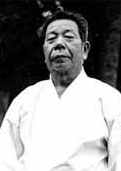 Morihiro
Saito was born in Ibaraki Prefecture in 1928. He was raised in a poor farming village. As a youth he studied kendo and Shinto-ryu karate. At age 18 he heard about a martial arts
master with remarkable technique in Iwama. Saito sought out O-sensei and was accepted as a student. In the years after the war Japan was near starvation, and all farm land had to be
worked. Saito had a job with the Japanese National Railroad, giving him a schedule of 24 hours on and 24 hours off. His schedule allowed him to spend a great deal of time working and
training with O-sensei. In particular, he was O-sensei's training partner during the development of the weapons aspect of Aikido. O-sensei deeded land beside the dojo to Saito, where he
built a house. He continued to serve O-sensei until the Founder's death in 1969. Prior to his death O-sensei made Saito the caretaker of the Aiki Shrine. Saito Sensei taught Aikido as
passed to him by the Founder, emphasizing strong fundamentals and the relation of the ken and jo to empty hand technique. He gained a strong following worldwide, and trained many
uchideshi from Europe, the US, and Australia. His Aikido and form of teaching came to be known as Iwama Style. He continued as the caretaker of the Aiki shrine, teaching at O-sensei's
Iwama dojo, until he passed away in 2002.
Morihiro
Saito was born in Ibaraki Prefecture in 1928. He was raised in a poor farming village. As a youth he studied kendo and Shinto-ryu karate. At age 18 he heard about a martial arts
master with remarkable technique in Iwama. Saito sought out O-sensei and was accepted as a student. In the years after the war Japan was near starvation, and all farm land had to be
worked. Saito had a job with the Japanese National Railroad, giving him a schedule of 24 hours on and 24 hours off. His schedule allowed him to spend a great deal of time working and
training with O-sensei. In particular, he was O-sensei's training partner during the development of the weapons aspect of Aikido. O-sensei deeded land beside the dojo to Saito, where he
built a house. He continued to serve O-sensei until the Founder's death in 1969. Prior to his death O-sensei made Saito the caretaker of the Aiki Shrine. Saito Sensei taught Aikido as
passed to him by the Founder, emphasizing strong fundamentals and the relation of the ken and jo to empty hand technique. He gained a strong following worldwide, and trained many
uchideshi from Europe, the US, and Australia. His Aikido and form of teaching came to be known as Iwama Style. He continued as the caretaker of the Aiki shrine, teaching at O-sensei's
Iwama dojo, until he passed away in 2002.
 Koichi Tohei was born in 1920 in
Tokyo. As a youth he suffered from pleurisy. He studied judo, and in 1940 began studying Aikido with O-sensei. Tohei advanced rapidly. He was drafted into the army in late 1942, and
served in China. He returned to Japan in 1946, and resumed training. In 1953, O-sensei sent Tohei to Hawaii for a year, to establish Aikido in the US. Tohei was the chief instructor of
the headquarters dojo in Tokyo at the time of O-sensei's death. In 1974 he left the Aikikai organization, forming his own Aikido organization, the Ki Society. Many high ranking
instructors followed him, including a number of those in Hawaii and on the west coast of the US. His Ki Society and schools of Ki-aikido remain active, although Tohei passed away in 2011.
Koichi Tohei was born in 1920 in
Tokyo. As a youth he suffered from pleurisy. He studied judo, and in 1940 began studying Aikido with O-sensei. Tohei advanced rapidly. He was drafted into the army in late 1942, and
served in China. He returned to Japan in 1946, and resumed training. In 1953, O-sensei sent Tohei to Hawaii for a year, to establish Aikido in the US. Tohei was the chief instructor of
the headquarters dojo in Tokyo at the time of O-sensei's death. In 1974 he left the Aikikai organization, forming his own Aikido organization, the Ki Society. Many high ranking
instructors followed him, including a number of those in Hawaii and on the west coast of the US. His Ki Society and schools of Ki-aikido remain active, although Tohei passed away in 2011.
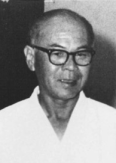 Isao Takahashi was born in Hawaii in 1912, and lived in Japan as a child. He was an accomplished practitioner of kendo and judo. Takahashi
was one of the first students of Koichi Tohei when he came to Hawaii in 1953. Takahashi moved to the mainland in 1960, becoming the chief instructor of the Los Angeles Aikikai. In 1965 he
moved on to Chicago, where he was instrumental in spreading Aikido in the central United States. He passed away in 1972.
Isao Takahashi was born in Hawaii in 1912, and lived in Japan as a child. He was an accomplished practitioner of kendo and judo. Takahashi
was one of the first students of Koichi Tohei when he came to Hawaii in 1953. Takahashi moved to the mainland in 1960, becoming the chief instructor of the Los Angeles Aikikai. In 1965 he
moved on to Chicago, where he was instrumental in spreading Aikido in the central United States. He passed away in 1972.
 Bill Sosa was born in 1934. He studied karate, judo, and boxing as a young man in Chicago. He discovered Aikido in his thirties,
becoming a student of Isao Takahashi in the mid-sixties. In 1972, after the passing of Takahashi, Sosa moved to Dallas and founded the Southwestern Aikido Institute. He remained
affiliated with Koichi Tohei when Tohei left the Aikikai in 1974. Sosa left Tohei's Ki Society in 1981 when Rod Kobayashi established Seidokan Aikido. Sosa remained with Seidokan until
1995 when he founded his own organization, the International Aikido Association. He continued to teach until he succumbed to cancer in 2002.
Bill Sosa was born in 1934. He studied karate, judo, and boxing as a young man in Chicago. He discovered Aikido in his thirties,
becoming a student of Isao Takahashi in the mid-sixties. In 1972, after the passing of Takahashi, Sosa moved to Dallas and founded the Southwestern Aikido Institute. He remained
affiliated with Koichi Tohei when Tohei left the Aikikai in 1974. Sosa left Tohei's Ki Society in 1981 when Rod Kobayashi established Seidokan Aikido. Sosa remained with Seidokan until
1995 when he founded his own organization, the International Aikido Association. He continued to teach until he succumbed to cancer in 2002.
 Aritoshi Murashige was a student of judo and Katori Shinto Ryu as a young man. He was one of several judo students that Jigoro Kano
sent to study with Morihei Ueshiba in the late 1920's. By 1933 he was teaching aiki budo in Japanese-controlled Manchuria. In 1953, O-sensei sent Murashige to Burma to teach Aikido. In
1962, he established a dojo in Belgium. He lived and taugh in Belguim until his death in an automobile accident in 1964.
Aritoshi Murashige was a student of judo and Katori Shinto Ryu as a young man. He was one of several judo students that Jigoro Kano
sent to study with Morihei Ueshiba in the late 1920's. By 1933 he was teaching aiki budo in Japanese-controlled Manchuria. In 1953, O-sensei sent Murashige to Burma to teach Aikido. In
1962, he established a dojo in Belgium. He lived and taugh in Belguim until his death in an automobile accident in 1964.
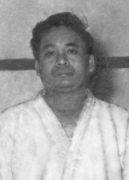 Sayagyi U Thaung Din was born in 1930 in Rangoon, Burma. He studied martial arts as a youth, and was introduced to English-style boxing while
living in India. In 1953, he became a student of Aritoshi Murashige. He formed the Burma Aikikai, an open air dojo at his own residence, in 1955. He kept Aikido alive in Myanmar during
the years of isolation imposed by the government, and reestablished ties with Hombu dojo in the nineteen nineties. He passed away in 1996.
Sayagyi U Thaung Din was born in 1930 in Rangoon, Burma. He studied martial arts as a youth, and was introduced to English-style boxing while
living in India. In 1953, he became a student of Aritoshi Murashige. He formed the Burma Aikikai, an open air dojo at his own residence, in 1955. He kept Aikido alive in Myanmar during
the years of isolation imposed by the government, and reestablished ties with Hombu dojo in the nineteen nineties. He passed away in 1996.
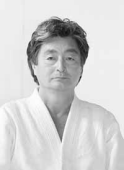 Yoshimitsu Yamada
was born in Tokyo in 1938. He became an uchi deshi at the Hombu Dojo in Tokyo in 1955. He moved to the US in 1966, taking over as the chief instructor of the New York Aikikai. He was
instrumental in spreading Aikido in the eastern United States, both as the leading Aikido teacher on the east coast, and bringing Mitsunari Kanai to Boston. Yamada Sensei was one of the
most well-known and active Aikido teachers, and taught seminars across the US and Latin America, as well as in other parts of the world. He passed away at the beginning or 2023.
Yoshimitsu Yamada
was born in Tokyo in 1938. He became an uchi deshi at the Hombu Dojo in Tokyo in 1955. He moved to the US in 1966, taking over as the chief instructor of the New York Aikikai. He was
instrumental in spreading Aikido in the eastern United States, both as the leading Aikido teacher on the east coast, and bringing Mitsunari Kanai to Boston. Yamada Sensei was one of the
most well-known and active Aikido teachers, and taught seminars across the US and Latin America, as well as in other parts of the world. He passed away at the beginning or 2023.
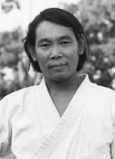 Mitsunari Kanai was born in Manchuria in 1939. He became an uchi-deshi at the Hombu dojo in Tokyo in 1958. He was sent to the United States in 1966, settling in Boston and founding
the New England Aikikai. He took a leading role in spreading Aikido in the eastern US, and in Canada where he died in 2004 of a heart attack during a seminar trip.
Mitsunari Kanai was born in Manchuria in 1939. He became an uchi-deshi at the Hombu dojo in Tokyo in 1958. He was sent to the United States in 1966, settling in Boston and founding
the New England Aikikai. He took a leading role in spreading Aikido in the eastern US, and in Canada where he died in 2004 of a heart attack during a seminar trip.
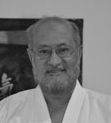 Ariff Mehter was born in Burma in 1945,
and began studying Aikido in 1962 with U Thaung Din. In 1968, he moved to New York State and began studying with Mitsunari Kanai and Yoshimitsu Yamada. Mehter founded Aikido of Central
New York in 1970. He moved to Kentucky in 1978 where he founded the KYOWVA Aikikai in Ashland. In 1989, he moved to Louisville where he founded the Kentuckiana Aikikai. In 1998 he moved
on to northern Kentucky. He now teaches at Aikido of Cincinnati.
Ariff Mehter was born in Burma in 1945,
and began studying Aikido in 1962 with U Thaung Din. In 1968, he moved to New York State and began studying with Mitsunari Kanai and Yoshimitsu Yamada. Mehter founded Aikido of Central
New York in 1970. He moved to Kentucky in 1978 where he founded the KYOWVA Aikikai in Ashland. In 1989, he moved to Louisville where he founded the Kentuckiana Aikikai. In 1998 he moved
on to northern Kentucky. He now teaches at Aikido of Cincinnati.
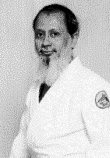 Yousuf Mehter was born in Burma in 1948. He was a
skilled athelete as a young man, playing on Burma's National field hockey team. He began his martial arts training at age 17. He trained under U Thaung Din in Burma, and under his
brother, Ariff Mehter, in the United States. He became the chief instructor of Aikido of Central New York in 1978, and continued teaching there until 2012. He now lives in Virginia,
and continues to teach seminars.
Yousuf Mehter was born in Burma in 1948. He was a
skilled athelete as a young man, playing on Burma's National field hockey team. He began his martial arts training at age 17. He trained under U Thaung Din in Burma, and under his
brother, Ariff Mehter, in the United States. He became the chief instructor of Aikido of Central New York in 1978, and continued teaching there until 2012. He now lives in Virginia,
and continues to teach seminars.
